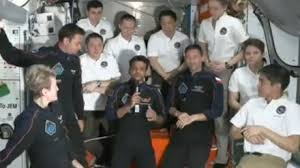‘Learning like a baby, new steps, how to eat’: Shubhanshu Shukla, first Indian on board the ISS

India has marked a historic milestone in space exploration. Group Captain Shubhanshu Shukla has become the first Indian astronaut to board the International Space Station (ISS). His arrival represents not only personal achievement but also a proud moment for the entire nation.
Launched on June 25 aboard SpaceX’s Crew Dragon “Grace”, Shukla is part of Axiom Space’s Ax-4 mission. The spacecraft docked with the ISS on June 26 at 5:45 PM IST. As Shukla floated into the space station, India held its breath and then cheered with joy.
“Like a Baby Learning to Walk”
Life in microgravity isn’t easy. However, Shukla embraced the challenge with wonder and humility.
“I’m learning like a baby again—how to walk, how to eat, even how to move my arms,” he said in his first message. “It’s not easy to stand here. But it’s worth every moment.”
This honest and poetic statement struck a chord with millions. His words made the surreal experience of space travel feel personal and real.
Journey of 1.4 Billion Dreams
Shukla’s achievement is more than just a first. It follows in the footsteps of Rakesh Sharma, who flew to space in 1984 aboard a Soviet mission. However, Sharma did not enter the ISS. Therefore, Shukla is the first Indian to live and work on the station.
From space, he greeted his country with emotion.
“Namaskar from space. I bring with me the dreams of 1.4 billion people. Jai Hind. Jai Bharat.”
Back home, his words sparked celebrations. ISRO scientists clapped. Students watched from classrooms. His family in Lucknow was overwhelmed with pride.
From Gajar Halwa to Space Science
Interestingly, Shukla didn’t leave Indian flavors behind. Thanks to ISRO and DRDO, his meals include gajar halwa, moong dal halwa, amras, and rice-based curries. These were specially prepared for space and packed in zero-gravity-friendly pouches.
Meanwhile, science remains his top priority. Shukla is performing seven experiments designed by Indian research teams. These include:
- Observing seed germination in zero gravity
- Studying tardigrade survival in extreme space conditions
- Monitoring algae growth in microgravity
- Tracking screen use effects on the human brain
- Examining muscle loss in astronauts over time
Each experiment contributes to India’s space goals. In particular, they prepare the country for the upcoming Gaganyaan mission scheduled for 2027.
The Man Behind the Mission
Shukla’s journey began long before launch. He is a trained Indian Air Force fighter pilot with years of discipline and courage behind him. Moreover, he was selected after a highly competitive screening process involving ISRO and Axiom Space.
Before takeoff, he said,
“This isn’t my journey alone. I carry the hopes of every Indian child who looks up at the stars and dreams of touching them.”
His parents were emotional. His mother cried tears of joy while watching the livestream. Meanwhile, his school in Lucknow organized a celebration, with students waving flags and cheering.
Why This Mission Matters
This mission isn’t only about individual success. It also shows India’s growing role in international space exploration. Axiom-4 is a commercial mission involving multiple countries and organizations like NASA, SpaceX, and ISRO.
For India, this is a crucial opportunity. It allows Indian scientists to run human-focused space experiments. In addition, it builds international partnerships that will be useful in future Moon and Mars missions.
Furthermore, private Indian companies in space tech, biotech, and education may benefit from the research conducted aboard the ISS.
A Glimpse Into the Future
Shukla’s success lays the foundation for India’s next steps. The Gaganyaan mission will build on this experience. So will ISRO’s ambitions to send astronauts to the Moon by 2040.
This mission is also a test of India’s ability to support astronauts in space for long periods. The results will influence everything—from spacecraft design to food packaging to life support systems.
In Space, With Heart
Despite the busy schedule, Shukla finds time to enjoy the moment. He spends part of his day looking at Earth from the ISS’s cupola window.
“From up here, borders vanish. You realize how precious our planet is,” he said. “I wish everyone could see this view once.”
His words serve as a gentle reminder. Space is vast, but Earth is home—and it’s worth protecting.
Conclusion
Shubhanshu Shukla’s entry into the ISS is a turning point for India. It blends science, emotion, and national pride into one powerful mission. As he floats 400 kilometers above Earth, learning to live all over again, he carries with him the dreams of a billion people—and opens a new chapter in Indian space history.
Jai Hind. Jai Vigyaan.






